Economic globalization
| Part of the Politics series on |
| Economic liberalism |
|---|
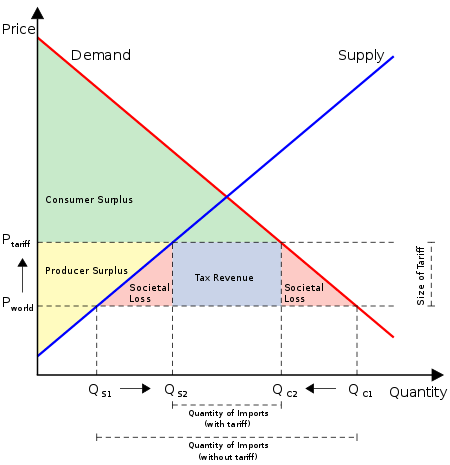 |
|
Origins |
|
Ideas
|
|
Economic globalization is one of the three main dimensions of globalization commonly found in academic literature, with the two others being political globalization and cultural globalization, as well as the general term of globalization.[1] Economic globalization refers to the free movement of goods, capital, services, technology and information. It is the increasing economic integration and interdependence of national, regional, and local economies across the world through an intensification of cross-border movement of goods, services, technologies and capital.[2] Whereas globalization is a broad set of processes concerning multiple networks of economic, political, and cultural interchange, contemporary economic globalization is propelled by the rapid growing significance of information in all types of productive activities and marketization, and by developments in science and technology.[3]
Economic globalization primarily comprises the globalization of production, finance, markets, technology, organizational regimes, institutions, corporations, and labour.[4] While economic globalization has been expanding since the emergence of trans-national trade, it has grown at an increased rate due to an increase in communication and technological advances under the framework of General Agreement on Tariffs and Trade and World Trade Organization, which made countries gradually cut down trade barriers and open up their current accounts and capital accounts.[3] This recent boom has been largely supported by developed economies integrating with majority world through foreign direct investment and lowering costs of doing business, the reduction of trade barriers, and in many cases cross border migration
While globalization has radically increased incomes and economic growth in developing countries and lowered consumer prices in developed countries, it also changes the power balance between developing and developed countries and affects the culture of each affected country. And the shifting location of goods production has caused many jobs to cross borders, requiring some workers in developed countries to change careers.[4]
Evolution of globalization
History
International commodity markets, labor markets, and capital markets make up the economy and define economic globalization.[5]
Beginning as early as 6500 BCE, people in Syria were trading livestock, tools, and other items. In Sumer, an early civilization in Mesopotamia, a token system was one of the first forms of commodity money. Labor markets consist of workers, employers, wages, income, supply and demand. Labor markets have been around as long as commodity markets. The first labor markets provided workers to grow crops and tend livestock for later sale in local markets. Capital markets emerged in industries that require resources beyond those of an individual farmer.[6]
Technology
Globalization is about interconnecting people around the world beyond the physical barrier of geographical boundaries.[7]
These advances in economic globalization were disrupted by World War I. Most of the global economic powers constructed protectionist economic policies and introduced trade barriers that slowed trade growth to the point of stagnation.[8] This caused a slowing of worldwide trade and even led to other countries introducing immigration caps. Globalization did not fully resume until the 1970s, when governments began to emphasize the benefits of trade.[9] Today, follow-on advances in technology have led to the rapid expansion of global trade.[10]
Three suggested factors accelerated economic globalization: advancement of science and technology, market oriented economic reforms, and contributions by multinational corporations.[9][11]
The 1956 invention of containerized shipping, along with increases in ship sizes, were a major part of the reduction in shipping costs.[12][13]
Policy and government
The GATT/WTO framework led participating countries to reduce their tariff and non-tariff barriers to trade. Governments shifted their economies from central planning to markets. These internal reforms allowed enterprises to adapt more quickly and exploit opportunities created by technology shifts.[14]
Multinational corporations reorganized production to take advantage of these opportunities. Labor-intensive production migrated to areas with lower labor costs, later followed by other functions as skill levels increased. Networks raised the level of wealth consumption and geographical mobility. This highly dynamic worldwide system and powerful ramifications.[15]
On 27 October 1986, the London Stock Exchange enacted newly deregulated rules that enabled global interconnection of markets, with an expectation of huge increases in market activity. This event came to be known as the Big Bang.
Global actors
International governmental organizations
An intergovernmental organization or international governmental organization (IGO) refers to an entity created by treaty, involving two or more nations, to work in good faith, on issues of common interest. IGO’s strive for peace, security and deal with economic and social questions.[5] Examples include: The United Nations, The World Bank and on a regional level The North Atlantic Treaty Organization among others.
International non-governmental organizations (NGOs)
- For more information, reference non-governmental organization (NGO)
Despite its activity within one nation, NGOs work towards solutions that can benefit undeveloped countries that face the backlash of economic globalization. Classified as any non-profit, voluntary citizens' group which is organized on a local, national or international level. NGOs perform various services and humanitarian functions, bring citizen concerns to Governments, advocate and monitor policies and encourage political participation through provision of information.[16]
Multinational corporations
One of the many changes they have brought to developing countries is increased automation, which may damage less-automated local firms and require their workers to develop new skills in order to transition into the changing economy, leaving some behind. The necessary education infrastructure is often not present, requiring a redirection of the government’s focus from social services to education.[6] Corporations have outsourced in recent years. In business, outsourcing involves the contracting out of a business process (e.g. payroll processing, claims processing) and operational, and/or non-core functions (e.g. manufacturing, facility management, call center support) to another party (see also business process outsourcing).
ECLAC states that in order to create better economic relations globally, international lending agencies must work with developing countries to change how and where credit is concentrated as well as work towards accelerating financial development in developing countries.[17] ECLAC further suggests that the United Nations expand its agenda to work more rigorously with international lending agencies and that they become more inclusive of all nations. Key factors in achieving universal competition is the spread of knowledge at the State level through education, training and technological advancements.[8] Economist Jagdish Bhagwati suggested that programs to help developing countries adjust to the global economy would be beneficial for international economic relations.[18]
Several movements, such as the fair trade movement and the anti-sweatshop movement, claim to promote a more socially just global economy. The fair trade movement works towards improving trade, development and production for disadvantaged producers. The fair trade movement has reached 1.6 billion US dollars in annual sales.[9] The movement works to raise consumer awareness of exploitation of developing countries. Fair trade works under the motto of "trade, not aid", to improve the quality of life for farmers and merchants by participating in direct sales, providing better prices and supporting the community.[10] Meanwhile, the anti-sweatshop movement is to protest the unfair treatment caused by some companies. Some global brands were found to do that before but they took some methods to support the labors soon after. The movement is taken to decrease the wrongdoing and gain the profits for labors.[14]
Race to the bottom
Globalization is sometimes perceived as a cause of a phenomenon called the "race to the bottom" that implies that multinational companies are constantly attempting to maintain or increase their influence in countries that are already reliant on foreign investment alone. Multinationals tend to target export dependent countries. Due to a rise in competition, underdeveloped countries are undercutting their competitors through lowering their labor standards thus lowering the labor costs for the multinational companies investing into them. Companies will deliberately move into countries with the most relaxed laws and regulations for labor standards allowing them to do whatever they want. This results in factories with harsh labor conditions, low wages, and job insecurity.[12]
Irreversibility
According to prominent Chinese economist Gao Shangquan, economic globalization is an irreversible trend due to the fact that world markets are in great need of science and information technologies. With the growing demands of science and technology, Gao states that with world markets take on an "increasing cross-border division of labor".[13]
However, Princeton University professor Robert Gilpin argues that nations' economic policies have mistakenly slowed their own growth by resisting globalization, showing that globalization is not irreversible.[19] Antonio L. Rappa agrees that economic globalization is reversible and cites International Studies professor Peter J. Katzenstein.[20] However Thomas Friedman argues in his book that globalisation is both irreversible and inevitable.[21]
Impact
Economic growth and poverty reduction
Economic growth accelerated and poverty declined globally following the acceleration of globalization.
Per capita GDP growth in the post-1980 globalizers accelerated from 1.4 percent a year in the 1960s and 2.9 percent a year in the 1970s to 3.5 percent in the 1980s and 5.0 percent in the 1990s. This acceleration in growth is even more remarkable given that the rich countries saw steady declines in growth from a high of 4.7 percent in the 1960s to 2.2 percent in the 1990s. Also, the non-globalizing developing countries did much worse than the globalizers, with the former's annual growth rates falling from highs of 3.3 percent during the 1970s to only 1.4 percent during the 1990s. This rapid growth among the globalizers is not simply due to the strong performances of China and India in the 1980s and 1990s—18 out of the 24 globalizers experienced increases in growth, many of them quite substantial."[22]
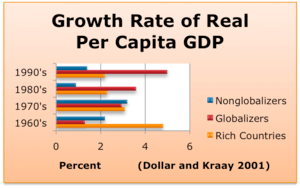
According to the International Monetary Fund, growth benefits of economic globalization are widely shared. While several globalizers have seen an increase in inequality, most notably China, this increase in inequality is a result of domestic liberalization, restrictions on internal migration, and agricultural policies, rather than a result of international trade.[22]
Poverty has been reduced as evidenced by a 5.4 percent annual growth in income for the poorest fifth of the population of Malaysia. Even in China, where inequality continues to be a problem, the poorest fifth of the population saw a 3.8 percent annual growth in income. In several countries, those living below the dollar-per-day poverty threshold declined. In China, the rate declined from 20 to 15 percent and in Bangladesh the rate dropped from 43 to 36 percent.[22]
Globalizers are narrowing the per capita income gap between the rich and the globalizing nations. China, India, and Bangladesh, once among the poorest countries in the world, have greatly narrowed inequality due to their economic expansion.[22]
Global supply chain
The global supply chain consists of complex interconnected networks that allow companies to produce handle and distribute various goods and services to the public worldwide.
Corporations manage their supply chain to take advantage of cheaper costs of production. A supply chain is a system of organizations, people, activities, information, and resources involved in moving a product or service from supplier to customer. Supply chain activities involve the transformation of natural resources, raw materials, and components into a finished product that is delivered to the end customer.[23] In sophisticated supply chain systems, used products may re-enter the supply chain at any point where residual value is recyclable. Supply chains link value chains.[24] Supply and demand can be very fickle, depending on factors such as the weather, consumer demand, and large orders placed by multinational corporations.[25]
Labor unions
Labor unions were established during industrialization as a solution to poor and unregulated working conditions. Unregulated businesses allowed for low wages, job insecurity and poor working conditions. Trade unions responded by implementing a technique called collective bargaining, where the workers could legally negotiate wages as well as working conditions. As a direct result, labors rights increased as policy and regulation were enforced. Alongside globalization, outsourcing developed which increased corporate power. As a solution, Labor Unions continue to fight for global labor rights standards through trans-national organizations.[26]
Capital flight
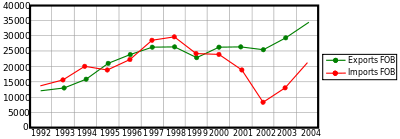
Capital flight occurs when assets or money rapidly flow out of a country because of that country's recent increase in unfavorable financial conditions such as taxes, tariffs, labor costs, government debt or capital controls. This is usually accompanied by a sharp drop in the exchange rate of the affected country or a forced devaluation for countries living under fixed exchange rates. Currency declines improve the terms of trade, but reduce the monetary value of financial and other assets in the country. This leads to decreases in the purchasing power of the country's assets.
A 2008 paper published by Global Financial Integrity estimated capital flight to be leaving developing countries at the rate of "$850 billion to $1 trillion a year."[27] But capital flight also affects developed countries. A 2009 article in The Times reported that hundreds of wealthy financiers and entrepreneurs had recently fled the United Kingdom in response to recent tax increases, relocating to low tax destinations such as Jersey, Guernsey, the Isle of Man and the British Virgin Islands.[28] In May 2012 the scale of Greek capital flight in the wake of the first "undecided" legislative election was estimated at €4 billion a week.[29]
Capital flight can cause liquidity crises in directly affected countries and can cause related difficulties in other countries involved in international commerce such as shipping and finance. Asset holders may be forced into distress sales. Borrowers typically face higher loan costs and collateral requirements, compared to periods of ample liquidity, and unsecured debt is nearly impossible to obtain. Typically, during a liquidity crisis, the interbank lending market stalls.
Inequality
While within-country income inequality has increased throughout the globalization period, globally inequality has lessened as developing countries have experienced much more rapid growth.[30] Economic inequality varies between societies, historical periods, economic structures or economic systems, ongoing or past wars, between genders, and between differences in individuals' abilities to create wealth.[31] Among the various numerical indices for measuring economic inequality, the Gini coefficient is most often-cited.
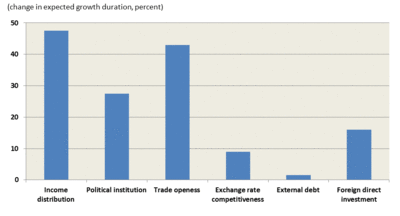
Economic inequality affects equity, equality of outcome and subsequent equality of opportunity. Although earlier studies considered economic inequality as necessary and beneficial,[33] some economists see it as an important social problem.[34] Early studies suggesting that greater equality inhibits economic growth did not account for lags between inequality changes and growth changes.[35] Later studies claimed that one of the most robust determinants of sustained economic growth is the level of income inequality.[32]
International inequality is inequality between countries. Income differences between rich and poor countries are very large, although they are changing rapidly. Per capita incomes in China and India doubled in the prior twenty years, a feat that required 150 years in the US.[36] According to the United Nations Human Development Report for 2013, for countries at varying levels of the UN Human Development Index the GNP per capita grew between 2004 and 2013 from 24,806 to 33,391 or 35% (very high human development), 4,269 to 5,428 or 27% (medium) and 1,184 to 1,633 or 38% (low) PPP$, respectively (PPP$ = purchasing power parity measured in United States dollars).[37]
Certain demographic changes in the developing world after active economic liberalization and international integration resulted in rising welfare and hence, reduced inequality. According to Martin Wolf, in the developing world as a whole, life expectancy rose by four months each year after 1970 and infant mortality rate declined from 107 per thousand in 1970 to 58 in 2000 due to improvements in standards of living and health conditions. Also, adult literacy in developing countries rose from 53% in 1970 to 74% in 1998 and much lower illiteracy rate among the young guarantees that rates will continue to fall as time passes. Furthermore, the reduction in fertility rates in the developing world as a whole from 4.1 births per woman in 1980 to 2.8 in 2000 indicates improved education level of women on fertility, and control of fewer children with more parental attention and investment.[38] Consequentially, more prosperous and educated parents with fewer children have chosen to withdraw their children from the labor force to give them opportunities to be educated at school improving the issue of child labor. Thus, despite seemingly unequal distribution of income within these developing countries, their economic growth and development have brought about improved standards of living and welfare for the population as a whole.
Recent developments, such as just-in-time manufacturing, have affected those working manufacturing jobs and agricultural work more than others. When larger companies or others who control the supply chain decide to reduce manufacturing, these people oftentimes find themselves out of a job with little or no assistance.[39]
Gender inequality
Health risks
Alongside globalization there is an increasing internationalization of health risks.[40] Corporations resort to outsourced employment in developing nations, which in turn forces low income foreigners at the bottom of the "food chain," as individuals drudge for pennies on the dollar under unregulated, unsanitary and implacable conditions. Women in agriculture, for example, are often asked to work long hours handling chemicals such as pesticides and fertilizers without any protection.[25] There are adverse health consequences from working long hours and individuals that burden themselves from working within vasts global supply chains.
Seth, Divya, and Nimali Singh published research evidence linking a wide range of health risks and overworking. The article argued that time is of the essence; in short time is a necessity for an individual's health whether the subject is behavior, vising the doctor’s office, and essential care.[41] There is a direct correlation with stress and has been the cause for 24% of cardiovascular disease cases including strokes and heart attacks.[41] Although both men and women experience shortcomings with health, the final reports stated that women, with the double burden of domestic and paid work experience an increased the risk of psychological distress and suboptimal health. Strazdins concluded that negative work-family spillover especially is associated with health problems among both women and men, and negative family-work spillover is related to a poorer health status among women."[42]
It is common for the work lifestyle to bring forth adverse health conditions or even death due to weak safety measure policies. After the tragic collapse of the Rana Plaza factory in Bangladesh where over 800 deaths occurred the country has since then made efforts in boosting up their safety policies to better accommodate workers.[43]
Mistreatment
Corporations set their place of production usually in areas with little to no labor regulations, and as a result low labor cost occurs. With the low labor regulations, there are risks for mistreatment of some workers, especially women and children.[44] Poor working conditions and sexual harassment are just some of the mistreatment faced by women in the textile supply chain. Marina Prieto-Carrón shows in her research in Central America that women in sweatshops are not even supplied with toilet paper in the bathroom everyday. The reason it costs corporations more is because people can not work to their full potential in poor conditions, affecting the global marketplace.[45] Furthermore, when corporations decide to change manufacturing rates or locations in industries that employ more women, they are often left with no job nor assistance. This kind of sudden reduction or elimination in hours is seen in industries such as the textile industry and agriculture industry, both which employ a higher amount of women than men.[25] One solution to mistreatment of women in the supply chain is more involvement from the corporation and trying to regulate the outsourcing of their product.[44]
Tax havens
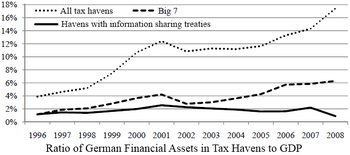
A tax haven is a state, country or territory where certain taxes are levied at a low rate or not at all, which are used by businesses for tax avoidance and tax evasion.[47] Individuals and/or corporate entities can find it attractive to move themselves to areas with reduced taxation. This creates a situation of tax competition among governments. Taxes vary substantially across jurisdictions.[48] Sovereign states have theoretically unlimited powers to enact tax laws affecting their territories, unless limited by previous international treaties. The central feature of a tax haven is that its laws and other measures can be used to evade or avoid the tax laws or regulations of other jurisdictions.[49] In its December 2008 report on the use of tax havens by American corporations,[50] the U.S. Government Accountability Office was unable to provide a satisfactory definition of a tax haven, but regarded the following characteristics as indicative of it: nil or nominal taxes; lack of effective exchange of tax information with foreign tax authorities; lack of transparency in the operation of legislative, legal or administrative provisions; no requirement for a substantive local presence; and self-promotion as an offshore financial center.
A 2012 report from the Tax Justice Network estimated that between USD $21 trillion and $32 trillion is sheltered from taxes in tax havens worldwide.[51] If such hidden offshore assets are considered, many countries with governments nominally in debt would be net creditor nations.[52] However, the tax policy director of the Chartered Institute of Taxation expressed skepticism over the accuracy of the figures.[53] Daniel J. Mitchell of the US-based Cato Institute says that the report also assumes, when considering notional lost tax revenue, that 100% of the money deposited offshore is evading payment of tax.[54]
The tax shelter benefits result in a tax incidence disadvantaging the poor.[55] Many tax havens are thought to have connections to "fraud, money laundering and terrorism."[56] Accountants' opinions on the propriety of tax havens have been evolving,[57] as have the opinions of their corporate users,[58] governments,[59][60] and politicians,[61][62] although their use by Fortune 500 companies[63] and others remains widespread. Reform proposals centering on the Big Four accountancy firms have been advanced.[64] Some governments appear to be using computer spyware to scrutinize corporations' finances.[65]
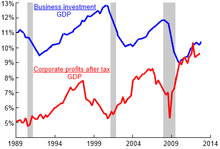
Voices of developing countries
The Economic Commission for Latin America and the Caribbean (ECLAC) has proposed an agenda to support conditions for developing countries to improve their standing in the global economy.[67] However, the advantaged countries continue to control the economic agenda. Lechner and Boli state that the World Bank and the International Monetary Fund must give voice to developing countries.[68]
Cultural effects
Economic globalization may affect culture. Populations may mimic the international flow of capital and labor markets in the form of immigration and the merger of cultures. Foreign resources and economic measures may affect different native cultures and may cause assimilation of a native people.[69] As these populations are exposed to the English language, computers, western music, and North American culture, changes are being noted in shrinking family size, immigration to larger cities, more casual dating practices, and gender roles are transformed.
Yu Xintian noted two contrary trends in culture due to economic globalization.[70] Yu argued that culture and industry not only flow from the developed world to the rest, but trigger an effort to protect local cultures. He notes that economic globalization began after World War II, whereas internationalization began over a century ago.[71]
George Ritzer wrote about the McDonaldization of society and how fast food businesses spread throughout the United States and the rest of the world, attracting other places to adopt fast food culture.[72] Ritzer describes other businesses such as The Body Shop, a British cosmetics company, that have copied McDonald's business model for expansion and influence. In 2006, 233 of 280 or over 80% of new McDonald's opened outside the US. In 2007, Japan had 2,828 McDonald's locations.[73]
Global media companies export information around the world. This creates a mostly one-way flow of information, and exposure to mostly western products and values. Companies like CNN, Reuters and the BBC dominate the global airwaves with western points of view. Other media news companies such as Qatar's Al Jazeera network offer a different point of view, but reach and influence fewer people.[74]
Migration
"With an estimated 210 million people living outside their country of origin (International Labour Organization [ILO] 2010), international migration has touched the lives of almost everyone in both the sending and receiving countries of the Global South and the Global North".[75] Because of advances made in technology, human beings as well as goods are able to move through different countries and regions with relative ease.
See also
Notes
- ↑ Babones, Salvatore (15 April 2008). "Studying Globalization: Methodological Issues". In George Ritzer. The Blackwell Companion to Globalization. John Wiley & Sons. p. 146. ISBN 978-0-470-76642-2.
- ↑ Joshi, Rakesh Mohan (2009). International Business. Oxford University Press, Incorporated. ISBN 978-0-19-568909-9.
- 1 2 Gao 2000, p. 4.
- 1 2 James et al., vols. 1–4 (2007)
- 1 2 School, Harvard Law. "Intergovernmental Organizations (IGOs) | Harvard Law School". Harvard Law School. Archived from the original on 21 December 2016. Retrieved 19 December 2016.
- 1 2 Mohr, Angie. "The Effects of Economic Globalization on Developing Countries". Demand Media.
- ↑ [Sumaira Aman 2017].
- 1 2 CEPAL 2002, p. 105.
- 1 2 3 Raynolds, Murray & Wilkinson 2007, p. 3.
- 1 2 Raynolds, Murray & Wilkinson 2007, p. 15.
- ↑ Thomas, Vladimir (May 1, 2017). The world transformed 1945 to the present (Second ed.). Michael H.hunt. pp. 427–429.
- 1 2 Olney, W. W. (2013). "A race to the bottom? Employment protection and foreign direct investment." Journal of International Economics, 91(2), 191–203.
- 1 2 Gao 2000.
- 1 2 unknown, unknown. "Anti-Sweatshop Movement Puts the Heat on Nike, Gap, and Levi's". Independent News & Media.
- ↑ Thomas, Vladimir (May 1, 2017). The world transformed 1945 to the present (Second ed.). Michael H.hunt. pp. 427–429.
- ↑ "DEFINITION OF NGOS". www.ngo.org. Retrieved 2016-12-19.
- ↑ CEPAL 2002, p. 102.
- ↑ Bhagwati, Jagdish (2003). "Globalization with a Human Face" (PDF). Archived from the original (PDF) on 28 September 2011.
- ↑ Little, Richard; Smith, Michael (27 October 2005). Perspectives on World Politics. Routledge. pp. 51–. ISBN 978-0-203-30052-7.
- ↑ Rappa, Antonio L. (2011). Globalization: Power, Authority, and Legitimacy in Late Modernity. Institute of Southeast Asian. pp. 15–. ISBN 978-981-4279-99-4.
- ↑ https://www.amazon.com/World-Flat-History-Twenty-first-Century/dp/0374292884
- 1 2 3 4 Dollar, David; Kraay, Aart. "Trade, Growth, and Poverty". Finance and Development. International Monetary Fund. Retrieved 6 June 2011.
- ↑ Kozlenkova, Irina V.; Hult, G. Tomas M.; Lund, Donald J.; Mena, Jeannette A.; Kekec, Pinar (2015-05-12). "The Role of Marketing Channels in Supply Chain Management". Journal of Retailing. 91 (4): 586–609. doi:10.1016/j.jretai.2015.03.003. ISSN 0022-4359.
- ↑ Anna., Nagurney, (2006-01-01). Supply chain network economics : dynamics of prices, flows and profits. Edward Elgar Pub. ISBN 1845429168. OCLC 317598837.
- 1 2 3 Spieldoch, Alexandra (2007). "A Row to Hoe: The Gender Impact of Trade Liberalization on our Food System, Agricultural Markets and Women's Human Rights". International Gender and Trade Network.
- ↑ Beladi, Hamid; Chao, Chi-Chur; Hollas, Daniel (2013-06-01). "Does globalization weaken labor unions in developing countries?". The Journal of International Trade & Economic Development. 22 (4): 562–71. doi:10.1080/09638199.2011.578752. ISSN 0963-8199.
- ↑ Illicit Financial Flows From Developing Countries: 2002–2006, Dev Kar and Devon Cartwright-Smith, 2008
- ↑ Hundreds of bosses flee UK over 50% tax, The Times, 13 December 2009
- ↑ Greek Euro exit looms closer as banks crumble
- ↑ Milanovic, B. (2012). "Global Income Inequality by the Numbers: In History and Now – An Overview". Policy Research Working Papers. doi:10.1596/1813-9450-6259.
- ↑ Kopczuk, Saez, and Song find that "most of the increase in the variance of (log) annual earnings is due to increases in the variance of (log) permanent earnings with modest increases in the variance of transitory (log) earnings." Thus, in fact, the increase in earnings inequality is in lifetime income. Furthermore, they find that it remains difficult for men to move up the earnings distribution, while women fare better. Kopczuk, Wojciech (2010). "Earnings Inequality and Mobility in the United States: Evidence from Social Security Data since 1937 *". Quarterly Journal of Economics. 125 (1): 91–128. doi:10.1162/qjec.2010.125.1.91.
- 1 2 Berg, Andrew G.; Ostry, Jonathan D. (2011). "Equality and Efficiency". Finance and Development. International Monetary Fund. 48 (3). Retrieved September 10, 2012.
- ↑ U.S. Income Inequality: It’s Not So Bad By Thomas A. Garrett| Federal Reserve Bank of St. Louis| Spring 2010
- ↑ Wilkinson, Richard; Pickett, Kate (2009). The Spirit Level: Why More Equal Societies Almost Always Do Better. Allen Lane. p. 352. ISBN 978-1-84614-039-6.
- ↑ Banerjee, Abhijit V.; Duflo, Esther (2003). "Inequality And Growth: What Can The Data Say?". Journal of Economic Growth. 8 (3): 267–99. doi:10.1023/A:1026205114860. Retrieved 25 September 2012.
- ↑ UNDP 2013, Introduction.
- ↑ UNDP 2013, p. 25.
- ↑ Wolf, Martin (2004). "Why Globalization Works". Yale University Press. Archived from the original on 10 May 2013. Retrieved 6 April 2013.
- ↑ "The vital role of women in agriculture and rural development". UN Women. Retrieved 2016-12-19.
- ↑ Pang, Tikki, and G. Emmanuel Guindon. "Globalization and Risks to Health." EMBO Reports.
- 1 2 Seth, Divya, and Nimali Singh. Adverse Health Consequences – A Result of Long Work Hours: A Review of The Current Evidence 3.1 (2016): n.p. Open Science Publications. Open Science Publications, 2016. Web.
- ↑ Strazdins, L., Welsh, J., Korda, R., Broom, D. and Paolucci, F. (2016), Not all hours are equal: could time be a social determinant of health?. Sociol Health Illn, 38: 21–42. doi:10.1111/1467-9566.12300
- ↑ Herlinger, Chris. "Bangladesh Counts The Human Cost Of The Garment Industry. (Cover Story)." National Catholic Reporter 52.14 (2016): 1–16. Academic Search Premier. Web
- 1 2 Prieto-Carrón, Marina. "Is there Anyone Listening?: Women Workers in Factories in Central America, and Corporate Codes of Conduct." Development 47.3 (2004): 101–05. ProQuest. Web.
- ↑ Berik, G., and Y. Van Der Meulen Rodgers. "What's Macroeconomic Policy Got to Do with Gender Inequality? Evidence from Asia." Global Social Policy 12.2 (2012): 183–89. Web
- ↑ Shafik Hebous (2011) "Money at the Docks of Tax Havens: A Guide", CESifo Working Paper Series No. 3587, p. 9
- ↑ Dharmapala, Dhammika und Hines Jr., James R. (2006) Which Countries Become Tax Havens?
- ↑ Moran Harari, Markus Meinzer and Richard Murphy (October 2012) "Financial Secrecy, Banks and the Big 4 Firms of Accountants" Tax Justice Network
- ↑ "The Truth About Tax Havens - retrieved 28 December 2007" (PDF). Retrieved 2011-03-22.
- ↑ "International Taxation: Large U.S. Corporations and Federal Contractors with Subsidiaries in Jurisdictions Listed as Tax Havens or Financial Privacy Jurisdictions GAO:GAO-09-157". Government Accountability Office. 18 December 2008. Retrieved 2009-01-21.
- ↑ Tax Justice Network (22 July 2012) "Revealed: Global super-rich has at least $21 trillion hidden in secret tax havens"
- ↑ Canadian Broadcasting Co. (22 July 2012) "Wealthy hiding $21 trillion in tax havens, report says"
- ↑ John Whiting, tax policy director at the UK's Chartered Institute of Taxation commented "There clearly are some significant amounts hidden away, but if it really is that size what is being done with it all?" and "If the suggestion is that such amounts are actively hidden and never accessed, that seems odd - not least in terms of what the tax authorities are doing. In fact, the US, UK and German authorities are doing a lot", and noting that if the figures were accurate "you would expect the havens to be more conspicuously wealthy than they are". However, he also admitted that "I cannot disprove the figures at all, but they do seem staggering" "Tax havens: Super-rich 'hiding' at least $21tn". BBC News. 2012-07-22. Retrieved 2012-10-03.
- ↑ "Fighting Anti-Tax Haven Demagoguery on CNN". 2012-07-30. Retrieved 2012-10-03.
- ↑ "Picking Up the Tab" U.S. Public Interest Research Group, April 2012
- ↑ "These Islands Aren’t Just a Shelter From Taxes" New York Times, 5 May 2012
- ↑ "Tax avoidance: fair or foul?" Archived 27 May 2013 at the Wayback Machine. Accountancy Age Debates, 14 January 2013
- ↑ "Google will not oppose clampdown on tax avoidance, chairman says" Guardian, 28 January 2013
- ↑ "Tax avoidance isn't a left or right issue, it's a cancer eating our democracy" New Statesman, 21 June 2012
- ↑ "Helsinki Boycotts Tax Havens", Inter Press Service, 6 October 2012
- ↑ "David Cameron: Tax avoiding foreign firms like Starbucks and Amazon lack 'moral scruples'" The Telegraph, 4 January 2013
- ↑ "Germany's Merkel calls for G8 fight against tax havens" Reuters, 13 February 2013
- ↑ "Which Fortune 500 Companies Are Sheltering Income in Overseas Tax Havens?" Citizens for Tax Justice, 17 October 2012
- ↑ "Britain could end these tax scams by hitting the big four" The Guardian, 10 December 2012
- ↑ "Did the Bounds of Cyber War Just Expand to Banks and Neutral States?" The Atlantic, 17 August 2012
- ↑ "Aggregate Demand, Instability and Growth" Review of Keynesian Economics, January 2013 (see also this review of the paper)
- ↑ CEPAL 2002, p. 95.
- ↑ Lechner, Frank J.; Boli, John (26 September 2011). The Globalization Reader. John Wiley Sons. p. 202. ISBN 978-0-470-65563-4.
- ↑ Held, David, ed. (2004). A Globalizing World?: Culture, Economics, Politics (2nd ed.). London; New York: Routledge, in association with the Open University. p. 84. ISBN 0-203-39219-1.
- ↑ Yu, Xintian (2002). Cultural Impact on International Relations. Chinese Philosophical Studies, XX. The Council for Research in Values and Philosophy. p. 203. ISBN 1-56518-176-X.
- ↑ Xintian, Yu (2002). Cultural Impact on International Relations. Chinese Philosophical Studies, XX. The Council for Research in Values and Philosophy. p. 204. ISBN 1-56518-176-X.
- ↑ Ritzer, George (2010). MacDonalization: the reader/ 3rd ed. Thousand Oak, CA: Sage Publications. p. 3. ISBN 978-1-4129-7582-7.
- ↑ Ritzer, George (2010). MacDonalization: the reader/ 3rd ed. Thousand Oak, CA: Sage Publications. pp. 5–7. ISBN 978-1-4129-7582-7.
- ↑ Nakayma, Thomas, K. The Handbook of Critical Intercultural communication. Blackwell. ISBN 978-1-4051-8407-6.
- ↑ Benería, Lourdes (2012). "Gender and International Migration: Globalization, Development, and Governance". Feminist Economics. 18 (2): 1–33. doi:10.1080/13545701.2012.688998.
References
- Gao, Shangquan (2000). "Economic Globalization: Trends, Risks and Risk Prevention: 2000" (PDF).
- Bordo, Michael D.; Taylor, Alan M.; Williamson, Jeffrey G. (1 November 2007). Globalization in Historical Perspective. University of Chicago Press. ISBN 978-0-226-06599-1.
- Held, David, ed. (2004). A Globalizing World?: Culture, Economics, Politics (2nd ed.). London; New York: Routledge, in association with the Open University.
- James, Paul; Gills, Barry (2007). Globalization and Economy, Vol. 1: Global Markets and Capitalism. London: Sage Publications.
- James, Paul; Patomäki, Heikki (2007). Globalization and Economy, Vol. 2: Global Finance and the New Global Economy. London: Sage Publications.
- James, Paul; Palen, Ronen (2007). Globalization and Economy, Vol. 3: Global Economic Regimes and Institutions. London: Sage Publications.
- James, Paul; O’Brien, Robert (2007). Globalization and Economy, Vol. 4: Globalizing Labour. London: Sage Publications.
- Raynolds, Laura T.; Murray, Douglas; Wilkinson, John (11 June 2007). Fair Trade: The Challenges of Transforming Globalization. Routledge. ISBN 978-1-134-00263-4.
- UNDP (2013). "Human Development Report 2013 - The Rise of the South: Human Progress in a Diverse World" (PDF). Retrieved 14 July 2014.
- Eun, Cheol S.; Resnick, Bruce G. (2012). International Financial Management. McGraw-Hill Education (Asia) and China Machine Press. ISBN 0-07-803465-5.
External links
